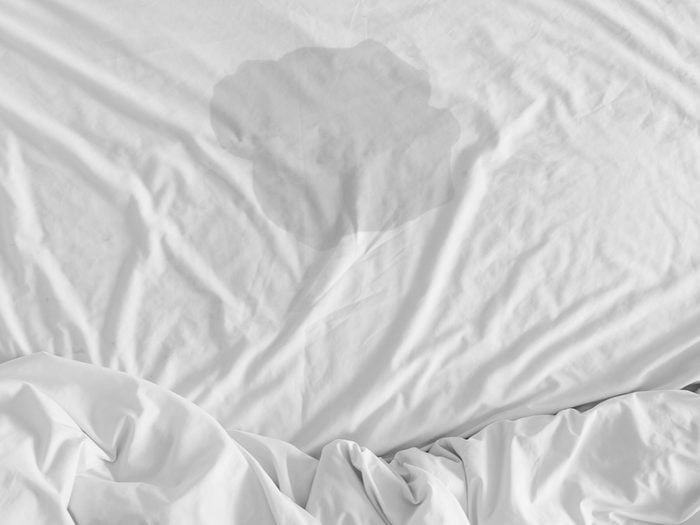Why Squirting Orgasms Are a (Really) Good Thing—And How to Have One

For some, it seems like an urban legend. But squirting orgasms are a thing, and everyone should try to have one.
A gushing, explosive waterfall between your legs that leaves you struggling for breath. The pinnacle female orgasm. Shejaculate. That’s how squirting has been portrayed in the media, in shows like Californication and movies like American Pie.
As much as it’s considered a rare and proud achievement, squirting is also assumed by many to be a myth—something movies and embellished pornography have tricked us to believe is totally doable, common even.
But the thing is, squirting is doable and not as rare as it may seem.
(Sign up for our Must Reads newsletter for more sex tips, and also beauty product recommendations and health stories!)
So, how do you squirt?
First, let’s establish what squirting is exactly—or try to. Turns out, its definition has been up for debate as far back as the 1600s, when Dutch physician and anatomist Regnier de Graaf became one of the radical few and first to take a scientific look at female ejaculation. He discovered it can be discharged when climaxing from what he referred to as the “female prostate.”
The “female prostate” is often referred to as the Skene’s glands (named after a man, naturally), which are two ducts located around the urethra, close to the bladder. The Skene’s glands are comparable to the male prostate (which, as a reminder, produces semen), and is where female ejaculate is released from.
“Female ejaculate wouldn’t have sperm or an egg in it, but it has the same function of creating lubrication and flushing the system,” says Megan Gilron, a Vancouver-based comprehensive sexual health educator. “It combines with the practice of urinating after having sex to clean everything out, so there’s no leftover bacteria that can cause problems [like urinary tract infections] later.”
Is it true it feels like pee comes out when you squirt?
The Skene’s glands’ proximity to the bladder is also why some have assumed female ejaculate is urine—but that’s not accurate, says Montreal-based Dr. Gabrielle Landry, who specializes in sexual wellness. “While it is not expressly urine,” the substance could contain some traces of it, she says. And yes, there’s a very strong chance a squirting orgasm will make you feel like you’re about to urinate, which is where a lot of the anxiety (and the thrill, let’s be honest) surrounding squirting can come in. But rest assured, that’s not what’s happening.
Research on squirting, in general, is minimal, but a 2018 study described the liquid as “a form of urine” that contains prostate-specific antigen with concentrations of urea, creatinine, and uric acid (all of which are found in urine). Still, the fluid produced is often clear or a murky white, far from a shade of yellow. In other words, it’s not as simple as straight-up pee.
Can anyone with a vagina squirt?
It depends on which data source you want to run with. For example, a 2013 study published in the Journal of Sexual Medicine found that anywhere from 10 to 54 percent of women can experience squirting. According to another 2013 study, women of all ages can ejaculate, and those who do produce two ounces of ejaculate each time. Clearly, more research needs to be done, but Gilron says it is possible, theoretically, for all women to squirt—it’s just something that takes work.
Okay, how do I have one?
The instructions for squirting are the same as any other sexual play— you need to be as comfortable and relaxed as possible because loose muscles are key. Communication is also essential if you’re attempting squirting with a partner. That can mean laying a towel down and having a conversation beforehand about what you want to do, how to do it and that, yes, it may get messy–but that’s all part of the fun.
It’s common to have anxiety around it, says Gilron. Particularly, it’s common to fear you might not actually squirt, but pee. These fears are similar to those issues surrounding anal play. But, the secret to squirting, says Gilron, is having trust and “overcoming the ick factor.”
She suggests a trusty technique: Your partner needs to use a “hooking motion,” where they will have their fingers inside you and find a walnut or pecan texture. They should then “hook and pull” that towards themselves in a kind of “come hither” motion. This is what we’ve come to know as stimulating the G-spot, which is actually more of an area than a specific, cute little target. “That [move] stimulates all the nerves and the muscles and that’s a very overwhelming feeling,” says Gilron. “If you’ve had a lot of water, you definitely can have projectile squirting.”
Wait, what? Here’s the thing: Drinking a lot of water before sex can lead to a more “spectacular” orgasm. According to Gilron, the more water in your system, the more likely you are to squirt. That’s because the fluid being expelled is largely water and that liquid has to come from somewhere. (So yes, that means being dehydrated can make reaching orgasm more difficult, too.)
On the other end of the squirting spectrum, you may just see a bit of a trickle—and that’s good too. As Gilron puts it, “it’s as if those two ducts are tear ducts, and they’re just having a little cry.”
What if it doesn’t work?
If this technique or any other doesn’t help you achieve a squirting orgasm, don’t fret. As with most things when it comes to sex, it can be different for everyone, and it can also take time, practice and different tools (i.e. hands, angled toys, vibrators, dildos, a penis). It also may not be as exciting for everyone! Whatever the case, the more you think about it, the more pressure you’re adding, and that’s a recipe for disaster.
“It’s healthy, it’s natural,” says Landry. “But I really want all women to know that if you never have it, that’s okay. It’s not because your partner is not good or there’s something wrong with your body. It’s really just a question of anatomy, and there is a lot of complexity when it comes to general orgasm.”
The unfortunate fact is that research on squirting remains limited. But pleasure will always be the bottom line, and that means normalizing every type of orgasm–no matter how wet.
Next: You Know Your Love Language—How About Your Sex Language?




